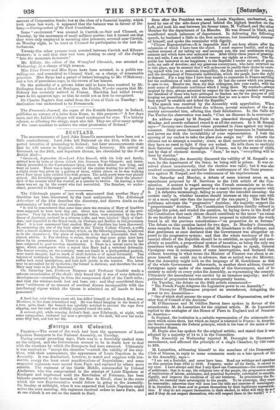SCOTLAND.
The announcements of Lord John Russell's movements have been not a little contradictory. Lord John left Balmoral on the 21st, with the re- ported intention of proceeding to Ireland; but later announcements state that he will return to England, after visiting Inverary- His arrival at Greenock on the 26th, and departure thence, are chronicled by the North British Mail- " Greenock, September 26.—Lord John Russell, with his lady and family, arrived here by train at eleven o'clock this forenoon from Glasgow; and imme- diately proceeded to the Customhouse Quay, where the Banshee was lying, and went on board. There was a large crowd at the station waiting his arrival and a slight cheer was given by a portion of them, whilst others as he was walking down East Quay Lane saluted him with groans. The noble party were very plainly attired. His Lordship appeared in good spirits, and walked about the quarter- deck of the steamer until she started, at a quarter to twelve. On leaving, a faint cheer was set up by the crowd who had assembled. The Banshee, we under- stand, proceeded to Inverary."
The Edinburgh papers of last week announced that another Mary of Gueldres has been discovered by the local antiquaries. The Edinburgh Advertiser of the 21st describes the discovery, and throws doubt on the authenticity of both the rival remains- " It will be remembered that some time since the remains of Mary of Guelders were supposed to have been dug out. Great was the admiration of the anti- quaries. They lay in state in the Exchequer Office, were cemented by the Pro- fessor of Anatomy, enclosed in a crimson coffin, and were labelled 'Mary of Guel- dere,' and deposited in the Royal vault, by Provosts and Baillies in full procession. Alas ! it is now announced that another Mary of Guelders has been discovered. In excavating the site of the high altar in the Trinity College Church, a coffin with a female skeleton was discovered, which, on the following grounds, is believed to be the Queen's-1. The place of sepulture is the most honourable that the church affords. 2. The skeleton is entire, showing that some pains have been taken for its preservation. 3. There is a cut in the skull, as if the body had been subjected to post mortem examination. 4. There is a lateral curve on the spine, which corresponds with a report that Mary had a vertebral deformity. The former remains, on the contrary, were not found in a distinguished position, were much decayed, had no mark of skull incision or of spinal tortuosity. The balance of testimony is, therefore, in favour of the later exhumation. But both coffins lack royal inscriptions, and both lack jewels in the interior. The latter may be accounted for by spoliation; the former is dubious; and therefore the real Mary may have to be yet discovered."
On Saturday last, Professor Simpson and Professor Goodsir made a minute examination of the skull: they found that it was of very defective development—resembling in form the compressed skull of the Carib tribe ; and that the wisdom-teeth had not been cut: and they considered there were "evidences of an amount of cerebral disease incompatible with the intellectual vigour which the Queen is admitted on all hands to have possessed."
A herd-boy, only thirteen years old, has killed himself, at Northesk Road, near Montrose, in the most determined way. Ile was found hanging to the branch of a tree, quite dead: the branch was carefully notched to prevent the rope from slipping, and the cord was skilfully adjusted round the neck.
A servant-girl, while crossing Arthur's Seat, near Edinburgh, at night, with some companions, ventured too near a precipice in the dark, fell over the rocks some fifty feet, and lost her life.


























 Previous page
Previous page